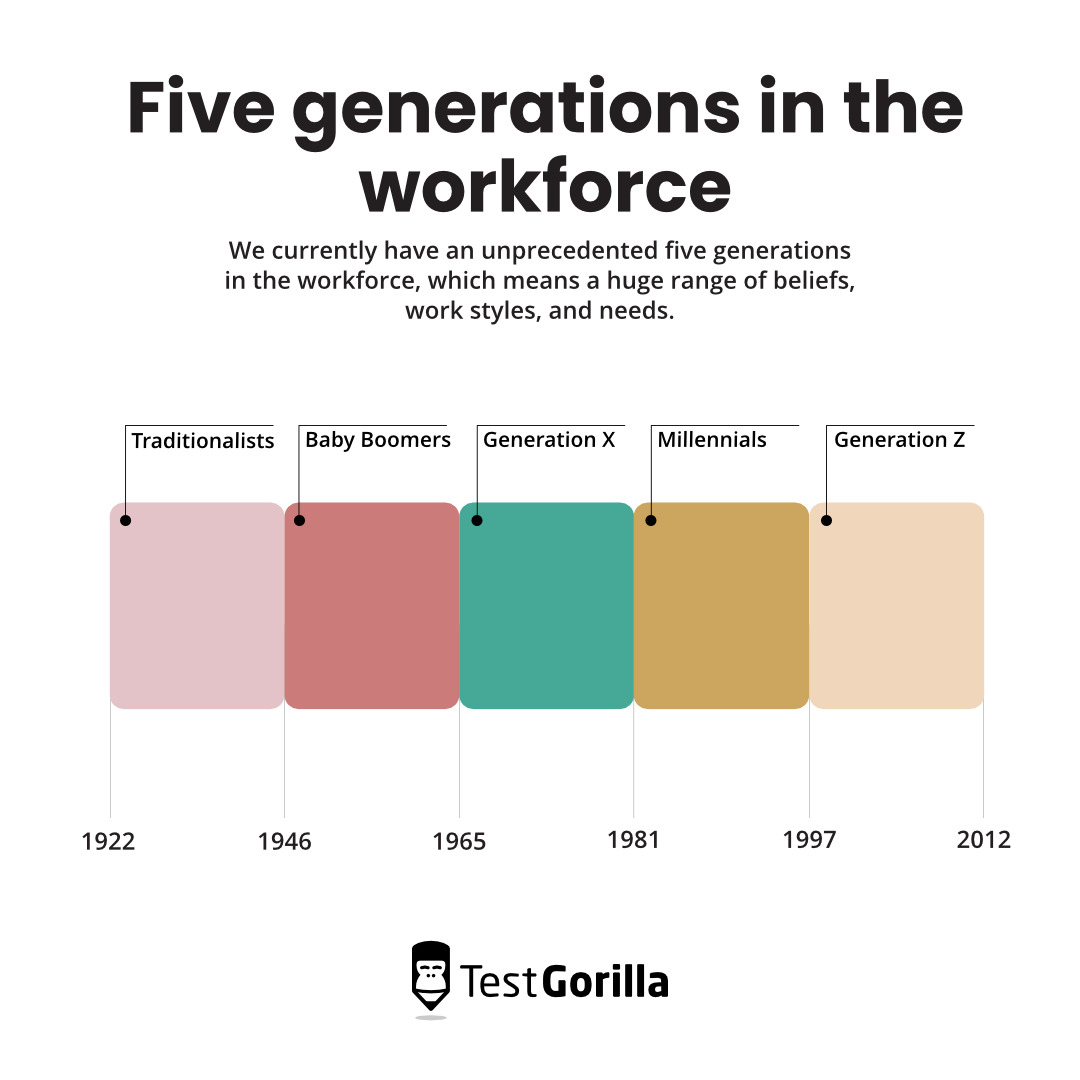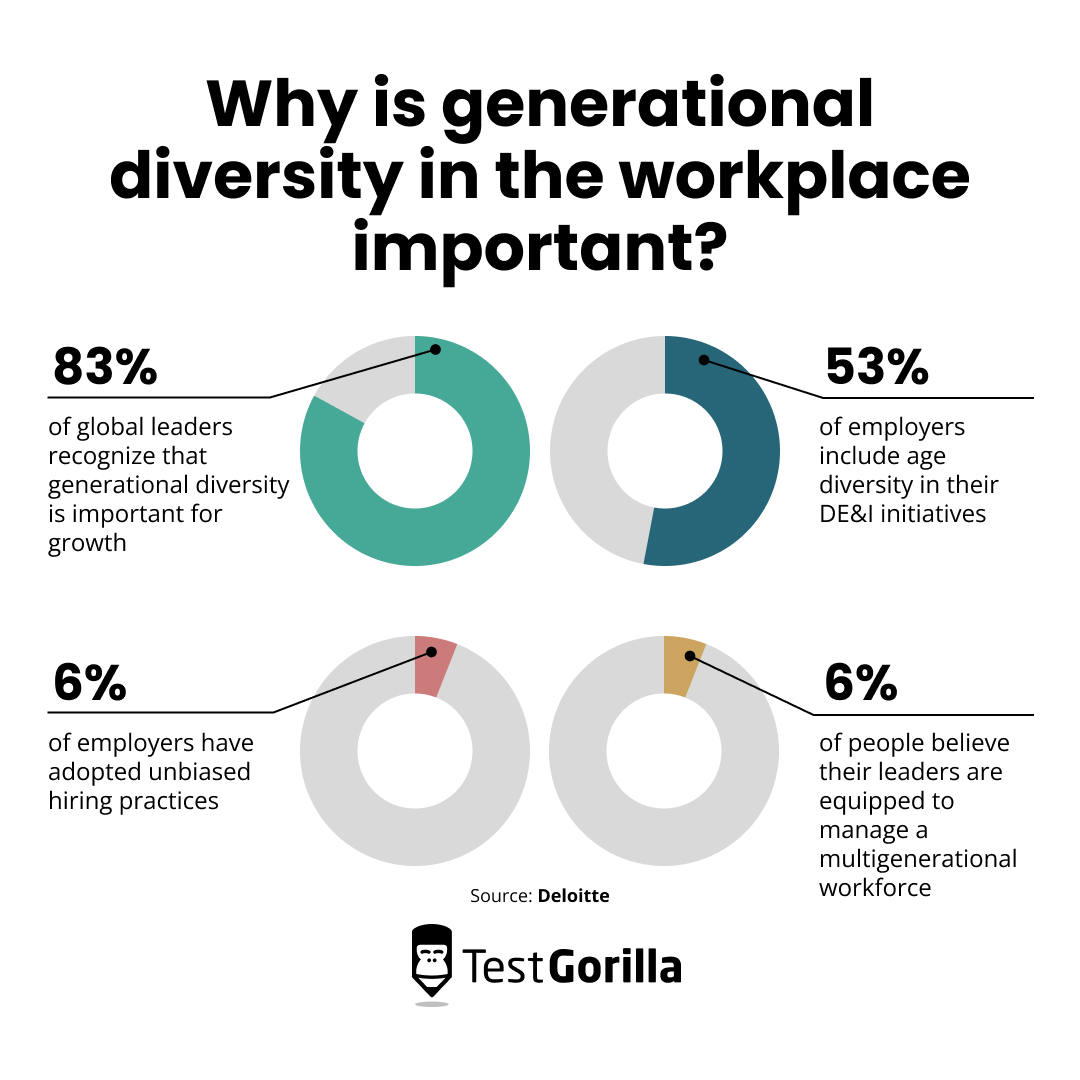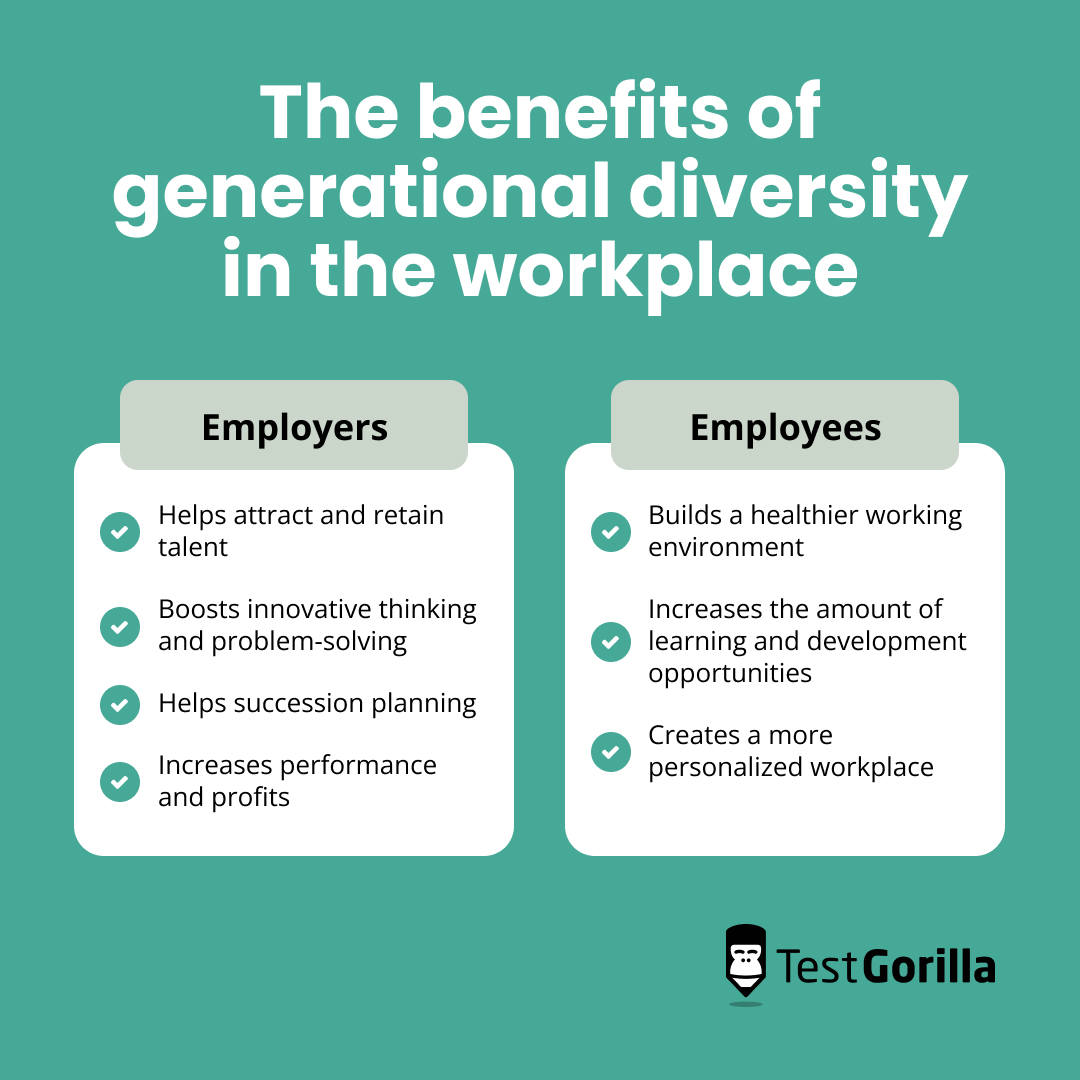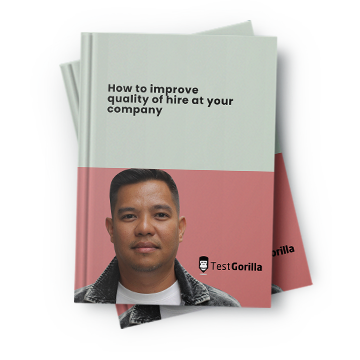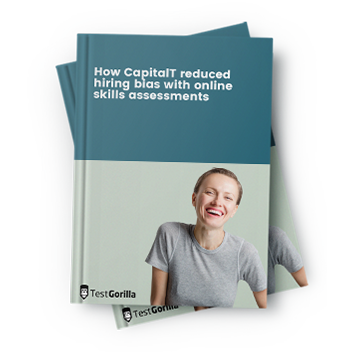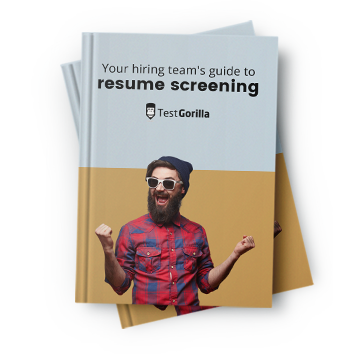Business metrics often overlook age-related diversity.
Generational diversity, which refers to workers of all ages being involved in today’s workforce, combats age discrimination and is good for your organization.
One study found that 86% of workers prefer working on a multigenerational team, and 86% also said multigenerational teams enable them to develop innovative ideas and products.[1]
Having multiple generations in your workforce makes your company more diverse, inclusive, and attractive, making generational diversity an excellent talent retention strategy.
We need a strong focus on incorporating different generations in one workplace, especially since five generations make up the workforce now.
We must create an inclusive hiring culture, overcome communication barriers, and recognize differences in how we work.
In this blog, we discuss the range of generations in the workforce, their main differences, and the top ten strategies to bring every generation together.
Table of contents
- What is generational diversity?
- Why is generational diversity in the workplace important?
- The benefits of generational diversity in the workplace
- The challenges of generational diversity at work
- 10 best practices for leveraging generational diversity to retain your best performers
- 3 examples of companies succeeding with generation diversity as a talent retention strategy
- Foster generational diversity by focusing on skills
What is generational diversity?
Generational diversity in the workplace is the concept of having multiple generations working together in one company, usually in one team or department.
Each generation brings its values, work and communication styles, traits, and preferences to the company culture.
Embracing generational diversity is essential because, for the first time, we have five generations in the workforce.
Generational diversity is an amazing opportunity, but it also means we have a lot of challenges, such as ageism and communication barriers, to address to manage these generations harmoniously.
Age and generation diversity is also important because the population is aging, with the percentage of older workers rising.
Reaping the benefits of generational diversity in the workplace is crucial, meaning your HR department must learn how to embrace an age-diverse workforce.
The different generations and their main characteristics
Fostering generational diversity is imperative to the health and productivity of your workplace, especially now.
We currently have an unprecedented five generations in the workforce, which means a huge range of values, work preferences, and needs.
It’s also worth noting generational differences are more drastic than they used to be. Because of rapid technological and social changes, there are wide gaps in generational beliefs and work styles.
Those generations are:
Traditionalists born between 1922 – 1945
Baby Boomers born between 1946 – 1964
Generation X born between 1965 – 1980
Millennials born between 1981 – 1996
Generation Z born between 1997 – 2012
Traditionalists
Traditionalists, also known as the silent generation, comprise 2% of the workforce and are mostly involved in decision-making.[2]
This demographic is straightforward, dependable, and conservative. Traditionalists lived through hard times like the Great Depression and the Second World War, which shaped them to favor stability and respect authority.
Here are the top distinguishing features of the traditionalist generation:
Values teamwork
Prioritizes loyalty
Prioritizes task orientation
Respects authority
Carefully follows directions
Prefers to communicate face-to-face
Baby Boomers
Baby Boomers comprise 25% of the workforce.[2]
This generation inherited many features from its traditionalist parents’ worldview, such as loyalty and commitment to duty. Baby boomers grew up in a time of prosperity, abundance, and economic growth that shaped them.
Here are the top distinguishing features of the baby boomer generation:
Values long-term relationships
Future-minded
Goal-focused
Committed to structure
Team-oriented
Prefers to communicate face-to-face and through phone calls
Generation X
Generation X comprises 33% of the workforce.[2]
Because of the rigid structure of the generations before it, this generation developed a healthy amount of independence and skepticism, which can make it prone to generational conflict.
It’s possibly owing to this independence that Generation X is the most likely to be a work leader, with Generation X accounting for 51% of leadership roles globally.[3]
Here are the top distinguishing features of Generation X:
Credited as creating the concept of work-life balance
Independent and self-sufficient
Values freedom and autonomy
Shuns micromanagement
As tech-savvy as millennials
Prefers to communicate through email and text message
Millennials
Millennials, also called Generation Y, comprise 35% of the workforce.[2]
This generation includes younger workers who grew up through a sudden surge in technology and many societal issues, which makes them choosy with their loyalty.
These upheavals helped to build the unflattering stereotype that millennials are “job-hoppers.” Jumping from job to job is largely necessary for this generation because the era they came of age in made it difficult to pay basic bills and pay off student debt.
For this reason, employers need to adjust their usual approach when hiring millennials.
Here are the top distinguishing features of the millennial generation:
Tech-savvy
Driven by goals and career growth
Family-centric
Prioritizes flexibility
Prone to job-hopping
Prefers to communicate through most online and mobile methods
Generation Z
Generation Z comprises 5% of the workforce.[2]
These people are known as “digital natives” because they were born into a high-tech era, with even the oldest of this generation being born in the late 1990s and having come to age during the Great Recession.
They’re also a progressive and forward-thinking generation, growing up with a modern mindset toward diversity as one of the most diverse generations in history.
Here are the top distinguishing features of Generation Z:
Employee compensation is a top priority
Diversity and inclusion are top priorities
Prioritizes values and mission
Tech-savvy
Prioritizes flexibility
Prefers to communicate through texting and video calls
Why is generational diversity in the workplace important?
Fostering diversity and generational differences in the workplace is critical. We need to prioritize coexistence for three main reasons:
We have five generations at work: For the first time, we have five unique generations in the workforce, including traditionalists, baby boomers, Generation X, millennials, and Generation Z.
A wider generational gap: Generations are more different than ever because of rapid advancements and change.
The population is aging: Many countries have an aging population, with older generations staying in the workforce longer. Research shows one in eight Americans was over 65 in the year 2000, but experts predict that is likely to change to one in five by the mid-2020s.
It also affects organizational performance. One study found that 83% of global leaders recognize that generational diversity is important for business growth and success.
However, only 53% include age diversity in their DE&I initiatives, and a minuscule 6% have adopted unbiased hiring practices.
Further, this survey found that only 6% of respondents believe their leaders can effectively manage a multigenerational workforce.
Here are some of the outcomes of embracing generational diversity:
Encourages a powerful sense of belonging: Fostering diversity helps more people feel like they belong, which leads to a better employee experience
Enables you to benefit from more knowledge and life experiences: Multigenerational teams have more knowledge-sharing opportunities from having different world experiences
Reduces groupthink and promotes new ideas: Generational diversity encourages employees to question the status quo in a healthy way, increasing innovation
Helps you serve different audiences: A multigenerational workforce helps you serve different client bases by having insights into what they need
Working with such a wide variety of people means generation diversity is vital to the modern workplace – and its importance is here to stay.
The benefits of generational diversity in the workplace
Nurturing generational diversity isn’t only a necessity for modern organizations. It carries many advantages, from innovation to a healthier culture.
Let’s discuss the benefits of generational diversity in the workplace for employees and employers.
The benefits for employers
First, let’s cover the benefits on the employers’ side.
1. Helps attract and retain talent
Nurturing generational diversity increases inclusivity, builds an accepting workplace, and reduces voluntary turnover.
You don’t want only one or two generations to feel valued.
Every employee needs to feel a sense of belonging; when they do, they’re more likely to remain at your company.
Employees who feel a strong sense of belonging versus a weak one experience a 50% reduction in turnover risk, a 75% decrease in sick days, and a 56% increase in job performance.
Fostering this diversity also helps attract new talent because these employees are also 167% more likely to recommend their company as a great workplace.
2. Boosts innovative thinking and problem-solving
Diversity in the workplace increases the amount of creativity in your company, encouraging new ideas and reducing groupthink.
Consider the different work styles and beliefs we described above. Each generation holds distinct methods of solving problems, working through conflict, and improving processes.
Diverse teams hold the key to increased innovation and productivity. The more diverse the range of lifestyles and life experiences, the more creativity.
It isn’t just inherent diversity, such as race and gender, that boosts innovation. It’s also acquired diversity, which you gain through life experiences.
3. Helps succession planning
Knowledge sharing is important for improved innovation and problem-solving, and it happens in two directions with a multigenerational workforce:
Younger generations inform older ones about current trends and what engages younger people
Older generations pass on practical experience to their younger colleagues
Travis Osborne, the vice president of IT for Apache Corporation, says effective succession planning needs fresh perspectives, not just someone who stays the course and doesn’t rock the boat.[4]
Succession planning helps companies stay on top of current events, trends, and demands while benefiting from older generations’ experiences.
4. Increases performance and profits
Generational diversity makes it easier to meet the needs of different audiences and tap into their mindsets, which helps you grow your customer base.
For example, if you have millennials and baby boomers working on your marketing strategy, it helps you leverage the large audience of those generations.
When millennials have $200bn in buying power and baby boomers have 70% of the disposable income in the US, this is a boon for any organization.[5] [6]
Besides expanding your audience reach, generation diversity also boosts performance. A highly inclusive environment can improve team performance by up to 30%.[7]
The benefits for employees
Now, let’s cover the benefits on the employees’ side.
1. Builds a healthier working environment
Generational diversity reduces bias regarding age because employees gain real-life experience working alongside older and younger teammates.
This culture means employees endure less discrimination and are accepted inclusively.
When employees have to question whether their age makes them unsuitable for a team, it creates feelings of unease.
However, an age-diverse workplace supports inclusivity and focuses more on the capabilities of its people.
An atmosphere like this improves mental health in the workplace by making your company more reliable and safe for every individual. It also boosts employee engagement and motivation.
With generational diversity, workers don’t have to worry about being judged for being “too old,” “too young,” or not the right “fit” because the team includes colleagues of all ages.
2. Increases the amount of learning and development opportunities
Greater generational diversity in the workplace creates more opportunities for development and internal mobility.
More value can be gained from mentoring and coaching when employees can benefit from their coworkers’ practical experience and different perspectives.
From the perspective of older workers, mentorship programs provide a way to grow in your career without leaving your role and industry.
This growth is important to employees.
One study found that 48% of workers would switch jobs for upskilling opportunities, and 65% believe that learning and development opportunities are important when considering a job offer.
For more information on how to offer these opportunities, read our guide on employee training programs.
3. Creates a more personalized workplace
Different age groups have different preferences. Personalized touches, like specific communication styles, help alleviate burnout and provide job satisfaction.
For example, if a Gen Z employee has to communicate through in-person meetings for updates instead of being able to text, they feel exhausted.
The same frustration happens to a baby boomer employee who wants to talk in person, but has to schedule Zoom meetings to discuss important topics.
These customized touches are an important part of employee recognition.
They aren’t a direct “thank you” but a way to show employees they’re appreciated.
The challenges of generational diversity at work
One of the top reasons companies struggle with generational diversity at work is intergenerational conflict.
Let’s take a look at the most common challenges of generational diversity.
Challenge | Description |
Ageism | Both younger and older employees face age discrimination like being rejected for job roles or passed over for growth opportunities. |
Communication styles | Different generations have diverse communication styles. Millennials prefer emails and texting is a key messaging strategy when hiring Gen Z workers. |
Different wants and needs | Each generation has unique work styles and benefit needs. Millennials and Gen Z like flexible work. |
Conflict and collaboration issues | Employees from different generations can run into team conflict. For example, baby boomers prefer a more hierarchical team structure and many Gen Xers prefer autonomy. |
Stereotypes | Damaging myths and stereotypes could lead colleagues to think an old employee has poor health or a young worker is a “partier.” |
Let’s briefly talk about how damaging stereotypes can be.
Stereotypes and cliches easily lead to age discrimination, but it’s more than that.
Many of these myths can be self-fulfilling prophecies. For example, the more a baby boomer employee hears new technology is hard to understand, the more likely they are to avoid it and struggle with it.
10 best practices for leveraging generational diversity to retain your best performers
Diversity and generational differences in the workplace are essential for a functioning company, but this harmony doesn’t happen on its own.
Here are our best practices to support age and generation diversity, including nurturing a positive culture and hiring people with talent assessments.
Strategies for fostering a multigenerational workforce: A summary
Strategy | What it accomplishes |
1. Foster an inclusive culture | Making people feel accepted improves wellbeing and encourages harmony |
2. Dedicate your organization to fair hiring | Using skills-based hiring methods enables you to hire whoever is best for the role, regardless of their age |
3. Use culture add to encourage generational diversity | Hiring for culture add stops problematic culture fit issues, like hiring young people because they “fit” the youthful culture |
4. Offer flexible work | Providing flexible work options enables employees to work how they need to, which is different for diverse generations |
5. Build communication strategies | Encouraging flexible communication enables everyone to communicate comfortably |
6. Encourage cross-generational teams and projects | Pairing intergenerational employees encourages good working relationships and creativity |
7. Set up mentoring and knowledge-sharing opportunities | Helping all employees find learning opportunities helps development and innovative thinking |
8. Actively work to eliminate stereotypes | Informing your workforce about biases and leading from the top helps raise awareness and build better behaviors |
9. Cater employee benefits to different generations | Offering diverse benefits helps employees leverage what’s best for them |
10. Ask your people what they need | Asking your workforce for insights tells you what they want and need and how you can support them |
1. Foster an inclusive culture
An inclusive culture is the concept of a company environment where every employee feels seen, heard, and accepted.
It is essential to support a diverse workforce, including generation diversity.
Here are a few inclusive generational diversity examples:
An older worker receives training so they can reskill to a new role, instead of the employer assuming that a baby boomer is “locked into” their original career
A Gen Z employee who moves to a leadership position, even though they’re younger than other leaders
An inclusive atmosphere ensures everyone feels valued and has the opportunity to succeed and is a key component in employee wellbeing.
Here are a few tips on building an inclusive culture:
Survey employees to see how included they feel
Assess your employees’ access to training
Analyze hiring patterns and promotion patterns
Set inclusion as a primary business goal
Establish a psychologically safe workplace
Lead by example
Encourage all types of diversity, such as age and neurotype diversity
Adopt inclusive hiring practices
Inclusive hiring practices are one of the most important aspects of an accepting culture. Let’s talk about that next.
2. Dedicate your organization to fair hiring
Inclusive hiring practices help avoid ageism and harmful hiring biases. Unfortunately, most issues surrounding generational diversity come down to biases and stereotypes.
Beliefs in untrue myths hurt real people, hold back thriving workplaces, and perpetuate age discrimination.
Hiring managers can reduce age bias by evaluating candidates through talent assessments. Skills-based hiring assesses real skills and capabilities instead of relying on work experience, education, resumes, and biased applications.
Here’s how you gauge candidate quality through skills tests.
Talent assessments focus on test scores that show a person’s real skills, giving all ages a fair chance. Instead of looking at graduation dates or years of experience, these tests simply show you how talented they are.
Nurturing generational diversity is simpler with skills-based hiring, and so is hiring the right people. This strategy increases diversity and finds the most qualified person for the job.
3. Use culture add to encourage generational diversity
Culture fit is the traditional way to find cultural alignment, but it can easily lead to age discrimination.
When companies advertise their culture as a "youthful team of digital natives" and reject applicants who aren’t a “fit,” it’s often because the person is too old.
Sophia Epstein, a BBC correspondent, puts it well:“[W]hen companies reject applicants based on cultural fit, they are likely perpetuating racism, ageism, and sexism in the process.”
We recommend hiring for culture add, which is finding similar core values and common ground, but valuing new beliefs and behaviors.
Hiring for culture fit perpetuates a company with primarily one or two different generations, but culture add promotes a workplace filled with generational diversity. It identifies what unites us, not what divides us.
4. Offer flexible work
Providing flexible work facilitates employing all types of people, no matter their schedules and lifestyles. Remote work is especially useful when millennial and Gen Z workers expect it.
For example, a more family-minded millennial could need to work remotely to care for their children, or a Gen Z worker still in college could need to work around their study schedule.
One of our top recommendations for motivating Gen Z employees is to offer remote and hybrid work.
The best way to do this is by creating a flexible work policy, so remote work is standardized and available to all employees. Check out our blog on building a remote work policy to learn how to make one.
5. Build communication strategies
Your entire workforce needs to approach communication with an open mind.
First, tailor your communication strategy to the employees you’re addressing. Your millennial workers may prefer communication via Slack, but baby boomers may appreciate phone calls.
Second, educate your workforce on varied communication needs to boost inclusivity and mitigate conflict.
Here are a few ways to encourage flexible communication:
Teach younger employees in-person communication skills
Teach older employees texting skills
Promote openness to learning new things
Train people to be flexible in their communication depending on who they’re talking to
If employees have different communication styles, don’t go against the grain. Work with your employees to communicate with each other in ways you all find comfortable and simple.
6. Encourage cross-generational teams and projects
It’s smart to take an active approach to generational diversity.
Encourage multigenerational teams to promote inclusion and innovation. For example, you can assign one project to a team of Gen X’ers and Gen Z’ers to get a broader perspective.
Assembling multigenerational teams accomplishes a lot:
Encourages team members to learn different perspectives
Gives a project a diverse range of innovation
Helps employees build relationships and break down generational stereotypes
Leverages the strengths of different generations
These multigenerational teams improve projects and performance and help build strong working relationships, nurturing a healthy culture.
7. Set up mentoring and knowledge-sharing opportunities
One of the main benefits of generational diversity in the workplace is knowledge sharing, so take the initiative to make it happen.
Remember that these opportunities aren't strictly one-way – younger generations benefit from older ones and vice versa.
Here are a few generational diversity examples of learning and development:
You hire a new millennial account executive and pair them with a baby boomer during onboarding to mentor them and answer their questions
A team of Gen Z employees gives a Gen X team insights for a marketing initiative aimed at a younger audience
Knowledge and innovation are two of your company’s biggest resources, so it’s critical to leverage them.
8. Actively work to eliminate stereotypes
Fostering generation diversity fights stereotypes, but it can’t be entirely passive. Take an active role in eliminating harmful biases.
A common way to combat stereotypes is by offering generational diversity training, which raises awareness and helps people recognize their biases.
It’s also important to talk with your people personally. Employee feedback tells people where they’ve made mistakes and how they can improve.
For example, if an employee uses a harmful ageist stereotype, take them aside and remind them gently that those words are harmful. It can also be something you bring up in your next one on one meeting.
You need to lead by example and work to recognize your own biases. The more you display the inclusive qualities you want to see, the faster your workforce adopts them.
9. Cater employee benefits to different generations
Diverse people need a range of employee benefits to satisfy and support them.
Learning opportunities, flexible work, and childcare matter in varying amounts to different generations at different points in their lives.
For example, a baby boomer or traditionalist could be interested in a phased retirement plan to gradually move out of the workforce.
Millennial employees could be interested in more career growth opportunities and flexible work.
Please note that although generations want similar benefits on average, talking to your people about their own needs is always important. Everyone’s different, and you wouldn’t want your benefits to fall prey to stereotyping.
For instance, an older employee can prefer remote work, even though it isn’t typical for their generation – they may have a medical condition or simply prefer their home owing to social anxiety.
10. Ask your people what they need
A huge part of embracing generational diversity is realizing that each employee is an individual, not just a generation.
One employee could tick every checkbox of being a typical millennial but prefers in-person conversations over email.
Practice employee listening and use surveys to find out what your multigenerational workforce needs.
Practices include:
Stay interviews
Pulse check surveys
Asking them during one-on-one meetings
Employee listening is healthy and productive, helping you improve your company by encouraging people to express their needs and advising managers through upward feedback.
This feedback helps you foster and support generation diversity and is also a crucial retention strategy.
3 examples of companies succeeding with generation diversity as a talent retention strategy
Let’s see a few companies thriving with generational diversity, supporting every person in their workforce, and staying on top of important retention trends across age groups.
It isn’t hard to support diversity in generations, and these organizations prove it.
Companies leveraging a multigenerational workforce: A summary
Company | Why it’s successful |
Barclays | Supports many different life stages and encourages all ages to pursue development |
PwC | Seeks out multigenerational learning opportunities and projects |
Later | Recruits millennial and Gen Z workers to harness their tech know-how |
Barclays
Barclays, a multinational bank, wants to help employees balance their work, personal lives, and development across all generations.
This company has a well-established framework for nurturing generational diversity and being open to many life stages, including parenthood, studies, and caring.
It was named a 2021 Seramount 100 Best Company for its commitment to programs such as parental leave, family support, workplace flexibility, and career growth.
Its upskilling practices are worth a special mention. Barclays’s apprenticeship program is proudly open to all types of people, welcoming teenagers to workers over 60.[8]
PwC
PwC, a multinational professional services group, leverages different generations to boost innovation.
Vicki Huff Eckert, the west region vice chair and a Gen X’er, talks about how she asked a group of Gen Z and millennials to research a market in which the company didn’t have a footprint.
In less than six weeks, this team talked to more than 200 companies, including the executives of many startups, through networking websites and social media.
It built a database of its findings and delivered a summary to the companies that requested it – and along the way, the team built a new business network for its company.[9]
But PwC also leverages the other type of knowledge sharing, partnering young employees with older ones so they can learn from their practical experience.[10]
Later
Later, a visual marketing platform for Instagram, intentionally seeks out generational diversity.
Roger Patterson, the chief executive, is a Gen X’er and actively seeks the opinions of millennials and Gen Z’ers.
He does this to promote inclusivity and harness the benefits of generational diversity, such as increased knowledge of digital trends from younger people.
Here are Roger’s main takeaways:
Accept that there are things you don’t know
Champion and support all experience levels and ages
Create opportunities for two-way learning
He says it’s vital for a social media business like his to leverage younger generations, but every industry should build a multigenerational workforce to maximize its potential.[11]
Foster generational diversity by focusing on skills
We must be mindful and respectful of generational diversity in the workplace and take active steps to handle it right.
This strategy not only helps our current workforce but prepares us for the future, too.
We recommend encouraging an inclusive culture, training employees on various communication styles, and focusing on skills rather than work history, resumes, and age.
These strategies help you manage generational diversity, promote better employee collaboration and teamwork, and ultimately increase your retention rate.
To read more about this, check out our blog on the importance of working relationships.
If you’d like to learn more about talent assessments and skills-based hiring, take a look at our test library.
Sources
1. “Impact of a multi-generational workforce”. (2018). Workforce Insights. Retrieved December 6, 2023. https://workforceinsights.randstad.com/hr-research-reports-workmonitor-q22018
2. Fry, Richard. (April 11, 2018). “Millennials are the largest generation in the U.S. labor force”. Pew Research Center. Retrieved December 6, 2023. https://www.pewresearch.org/short-reads/2018/04/11/millennials-largest-generation-us-labor-force/
3. “Global Leadership Forecast 2018”. (2018). DDI World. Retrieved December 6, 2023. https://www.ddiworld.com/research/global-leadership-forecast-2018
4. DiLorenzo Jr, Lou, et al. (March 7, 2022). "Looking beyond the horizon: How CIOs can embed DEI into succession planning". Deloitte Insights. Retrieved December 6, 2023. https://www2.deloitte.com/us/en/insights/topics/value-of-diversity-and-inclusion/diversity-and-inclusion-in-tech/dei-succession-planning-strategies.html
5. Carter, Christine Michel. (December 21, 2016). "The Complete Guide To Generation Alpha, The Children Of Millennials". Forbes. Retrieved December 6, 2023. https://www.forbes.com/sites/christinecarter/2016/12/21/the-complete-guide-to-generation-alpha-the-children-of-millennials/
6. "Baby Boomer Report". (2015). U.S. News. Retrieved December 6, 2023. https://www.usnews.com/pubfiles/USNews_Market_Insights_Boomers2015.pdf
7. Kostoulas, John. (August 30, 2018). “Technologies Are Critical for Inclusion in the Workplace”. LinkedIn. Retrieved December 6, 2023. https://www.linkedin.com/pulse/technologies-critical-inclusion-workplace-john-kostoulas/
8. "Multigenerational - Empowering all stages of our lives". Barclays. Retrieved December 6, 2023. https://home.barclays/who-we-are/our-strategy/diversity-and-inclusion/multigenerational/
9. Huff Eckert, Vicki. (September 23, 2019). "They lead, we coach: A multigenerational approach to innovation". Strategy + Business. Retrieved December 6, 2023. https://www.strategy-business.com/blog/They-lead-we-coach-A-multigenerational-approach-to-innovation
10. Sladek, Sarah. (June 26, 2018). "Best Companies Bridge The Generation Gap". Sarah Sladek. Retrieved December 6, 2023. https://www.sarahsladek.com/best-companies-bridge-the-generation-gap/
11. Patterson, Roger. (June 30, 2021). "Why this founder is all in on a multigenerational workforce". Fast Company. Retrieved December 6, 2023. https://www.fastcompany.com/90649641/why-this-founder-is-all-in-on-a-multigenerational-workforce
Related posts
Hire the best candidates with TestGorilla.
Create pre-employment assessments in minutes to screen candidates, save time, and hire the best talent.
Latest posts
The best advice in pre-employment testing, in your inbox.
No spam. Unsubscribe at any time.

Hire the best. No bias. No stress.
Our screening tests identify the best candidates and make your hiring decisions faster, easier, and bias-free.
Free resources
Anti-cheating checklist
This checklist covers key features you should look for when choosing a skills testing platform
Onboarding checklist
This resource will help you develop an onboarding checklist for new hires.
How to find candidates with strong attention to detail
How to assess your candidates' attention to detail.
How to get HR certified
Learn how to get human resources certified through HRCI or SHRM.
Improve quality of hire
Learn how you can improve the level of talent at your company.
Case study: How CapitalT reduces hiring bias
Learn how CapitalT reduced hiring bias with online skills assessments.
Resume screening guide
Learn how to make the resume process more efficient and more effective.
Important recruitment metrics
Improve your hiring strategy with these 7 critical recruitment metrics.
Case study: How Sukhi reduces shortlisting time
Learn how Sukhi decreased time spent reviewing resumes by 83%!
12 pre-employment testing hacks
Hire more efficiently with these hacks that 99% of recruiters aren't using.
The benefits of diversity
Make a business case for diversity and inclusion initiatives with this data.





